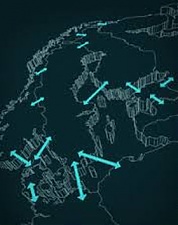Baltic, Energy, Energy Market, EU – Baltic States, Good for Business, Markets and Companies
International Internet Magazine. Baltic States news & analytics
Friday, 26.04.2024, 13:08
Estonia's electricity output grows 15% in 2016
 Print version
Print version |
|---|
The growth was due to a more favorable competition situation, supported by a drop in Nordic reservoirs' water levels in the second half of the year and lower carbon emission quota prices compared to the previous year, the transmission system operator Elering said.
Electricity consumption increased 3% over the year to 8.39 TWh and the electricity balance had a surplus of 2.04 TWh.
The growth in production was primarily based on fossil fuels whereas renewable energy production declined 6%. Electric energy produced from renewable sources accounted for 15.1% of domestic consumption.
The amount of electricity fed into the Estonian network from neighboring countries fell by a third compared to the previous year. Power flows from Finland to Estonia totaled 3.05 TWh and 0.52 TWh came from Latvia and Russia. Power flows out of Estonia decreased by 11%, with 0.68 TWh moving from Estonia to Finland and 4.92 TWh to Russia and Latvia. Transit flows through the Estonian electricity network amounted to 3.21 TWh,representing a drop of 35 percent from 2015.
In Latvia electricity production increased 17% to 6.22 TWh, supported by better hydro resource availability which boosted the overall output of the hydropower plants on the River Daugava by more than a third. Consumption grew 2% to 7.22 TWh. The Latvian electricity balance ran a deficit of 1.01 TWh. Domestic output covered 86% of consumption.
Lithuania's electricity production dropped 19% while consumption grew 6%. Output totaled 2.66 TWh and consumption, 10.11 TWh. The deficit of the Lithuanian electricity system thus was 7.45 TWh, nearly a fifth larger than a year earlier. Lithuanian producers covered 26% of domestic consumption.
Gross electricity production in the Baltic states increased 9% over the year, totaling 19.3 TWh, and consumption grew 4%to 25.72 TWh. The electricity balance deficit fell 10% to 6.42 TWh. This shortfall constituted 25% of electricity consumption in the three countries. An estimated 55% the deficit was covered by imports from Nordic countries.








 «The Baltic Course» Is Sold and Stays in Business!
«The Baltic Course» Is Sold and Stays in Business!

